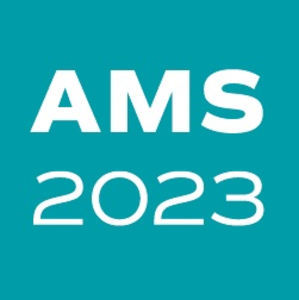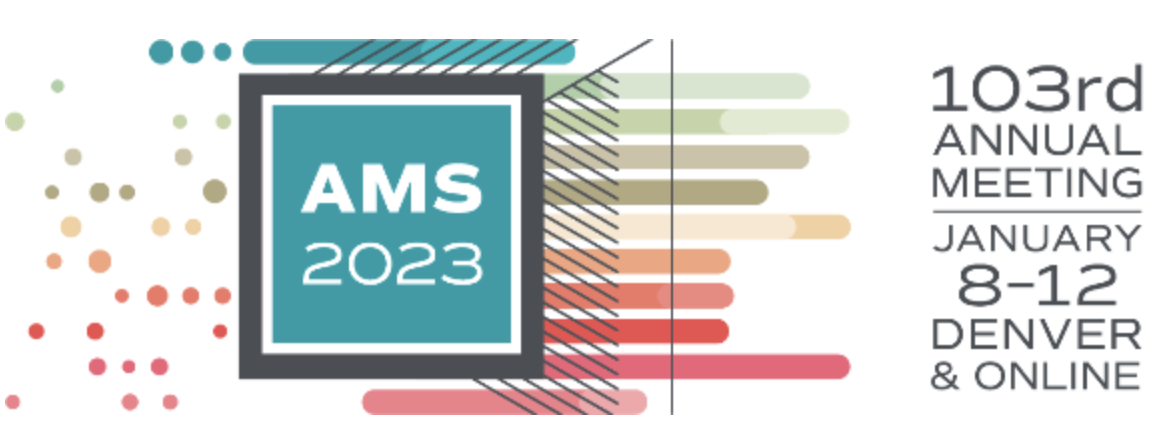GSL highlights at 2023 American Meteorological Society Annual Meeting


The American Meteorological Society (AMS) Annual Meeting is GSL's biggest meeting of the year to share our science. We have more than 60 presentations! Highlights are listed below.
MONDAY, JANUARY 2023
8:45 - 9:00 CCC 302 Dynamic Ensemble-based Scenarios for Impact-based Decision Support (DESI) - Travis Wilson. DESI is one of the newest multi-year research-to-operation prototype projects in the National Weather Service and is currently being evaluated by the NWS Operations Proving Ground and operational forecasters.
9:15 - 9:30 CCC 708 Progression Towards The First Operational Implementation Of The UFS-Based Rapid Refresh Forecast System As A Convection Allowing Model Application - Curtis Alexander. The RRFS will be NOAA’s flagship hourly updating, convection-allowing deterministic and ensemble prediction system and, with its implementation, will facilitate the retirement of several operational convection-allowing modeling (CAM) systems in the present production suite.
10:45 - 11:00 CCC 402Investigating Climate Drivers to Improve Prediction of West Nile Virus Disease Cases in the U.S. - Karen Holcomb. A team of NOAA Scientists discusses their investigation into environmental factors that influence the spread of the West Nile Virus using statistical time series modeling and machine learning.
11:00 - 11:15 CCC 708 Impacts of Different Physics Suites on the Hurricane Analysis and Forecast System Performances - Linlin Pan. A discussion of the impacts of different physics suites on hurricane forecasts using the Unified Forecast System (UFS) based Hurricane Analysis and Forecast System (HAFS).
11:15 - 11:30 CCC 2A/3A Ballroom Temporal Evolution of the 3-D Structure for the 30 Dec 2021 Marshall CO Windstorm/Fire in Observations and NWP Forecasts - Stan Benjamin. We summarize a set of observations and analyses for the Marshall windstorm and fire event on 30 December 2021.
11:15 - 11:30 CCC 302 ICAMS Committee on Research and Innovation Wildland Fire Workshop Series: Discussing Challenges and Opportunities for Wildland Fire Meteorological Services and Supporting Research Coordination Across the Federal Government - Dave Turner. This talk will present highlights from the workshop such as pre-and post-fire modeling and analysis efforts, centralizing federal wildland fire weather internet presence, and improved modeling applications for key elements such as high-resolution wind fields.
11:15 - 11:30 CCC 709 Using Weather Forecasts to Predict the Evolution of Wildfires for Smoke Forecasting - Laura Thapa. In this study, we use the hourly wildfire potential (HWP), a new diagnostic product developed at GSL, to generate a forecast of FRP that moves beyond the HRRR-Smoke assumption and incorporates the influence of weather on wildfire behavior. The HWP is based on air temperature, humidity, wind gust potential, and soil moisture.Posters 17:00 - 18:30 CCC Hall A- Threats-in-Motion Development within Hazard Services - Kevin Manros. Threats in Motion (TIM) is the concept where severe convective warnings move along with the storm, providing more lead time for areas in the path of the storm. This poster explores the implementation of TIM from research to operations.
- Quantifying the Benefits of Using Hazard Services to Communicate Hazardous Weather Information - Ethan Carr. This presentation will explore various hazardous weather workflows (e.g. Storm Surge Watch/Warning), both in their current and future states, and quantify the benefits of moving NWS watch/warning advisories into HS for operations.
TUESDAY, JANUARY 10
9:20 NOAA Booth: Progress toward initial operational implementation of the UFS-based Rapid Refresh Forecast System - Steve Weygandt
9:30 - 9:45 CCC 507 An hourly wildfire potential index for predicting sub-daily fire activity based on rapidly-updating convection-allowing model forecasts - Eric James. The Hourly Wildfire Potential can help forecasters anticipate dangerous fire weather conditions, and also paves the way for improved prediction of wildfire smoke emissions for use in the coming hours and days.
9:30 - 9:45 CCC 507 Modernized Forecasts and Warnings for the High Seas - Nathan Hardin. Currently, an effort is underway to revolutionize the way forecasts and warnings are created and communicated for the High Seas, using Hazard Services. Hazard Services, an AWIPS software application, represents a paradigm shift in how the National Weather Service communicates hazardous weather information and streamlines NWS operations into a single interface to provide modern, accurate, and timely hazard information.
13:45 - 14:00 CCC 302 Hazard Services Development at NOAA’s Global Systems Laboratory: 2023 Update - Darrel Kingfield. NOAA’s Global Systems Laboratory (GSL) is responsible for requirements gathering, design, and implementation of all other forecast and hazardous weather workflows used by NWS offices and National Centers for Environmental Prediction (NCEP) offices into the Hazard Services framework. This presentation will provide the audience with an overview of these development efforts and summarize its current progress toward NWS operations.
14:20 - 14:30 NOAA Booth: GSL’s DESI application - Travis Wilson
15:00 - 15:10 NOAA Booth: GSL’s Storm Surge in Hazard Services - Taylor Trogdon or Nate Hardin
15:45 - 16:00 CCC 504 The Marshall Fire: A NOAA Perspective on the Most Urgent Fire Weather Research Needs - (Invited) Jennifer Mahoney
Director of the NOAA GSL Laboratory, Jenn Mahoney, reviews one of the worst fires in Colorado’s history from the modeling, prediction, and communications perspective. The presentation covers what was learned and what is still needed in fire weather research.
16:20 - 16:30 NOAA Booth: Hazard Services - Darrel Kingfield
- (566) Evaluating Hub-Height Wind Forecasts in Offshore Regions using the Global Forecast System - Allison Van Ormer. Hub-height wind forecasts allow for the integration of wind-power into the usable climate grid. Accurate and fast forecasts are crucial in making the grid more efficient and resilient. This poster explores the strengths and weaknesses of the GFS hub-height wind forecasts in energy modeling.
- (638) Assimilation of Satellite Radiance Data in a Prototype RRFS: Recent Updates and Ongoing Work - Haidao Li. Global Systems Laboratory (GSL) is working in conjunction with NCEP/EMC toward the planned operational implementation of the Rapid Refresh Forecast System (RRFS), including enhanced satellite radiance assimilation capabilities, with plans to be operational in 2024. NOAA’s Haidao Lin discuss the testing of radiance data assimilation and impacts.
WEDNESDAY, JANUARY 11
9:30 - 9:45 Mile High Ballroom 1CD Enhancing Aviation Weather Forecasts with the Use of Air Traffic DataEnhancing Aviation Weather Forecasts with the Use of Air Traffic Data - Dana Uden. Air traffic densities computed from the Traffic Flow Management System data have been used in a variety of ways in the evaluation of aviation weather forecasts.
9:40 - 9:50 NOAA Booth: GSL’s DESI application -- Travis Wilson
11:15-11:30 CCC 103/105 Towards the Next Generation of Air Quality Forecast Models with NOAA's High-Resolution Rapid-Refresh Model Coupled to Chemistry (HRRR-Chem) - Jordan Schnell
Experimental air quality forecasts with the High-Resolution Rapid-Refresh model coupled to chemistry (HRRR-Chem) at NOAA ESRL began in August 2022.
11:30-11:45 CCC 104/106 How Using Machine Learning Improves Hourly Fire Radiative Power for Smoke Modeling - Christina Kumler
In new work, a newly blended geostationary and polar-orbiting satellite FRP product known as RAVE was combined with High Resolution Rapid Refresh (HRRR) weather inputs to create an hourly FRP prediction to be used in new RF smoke models.
11:30 AM - 11:45 CCC 103/105 NOAA’s Global Aerosol Forecast Capabilities: GEFS-Aerosols and UFS-Aerosols - Li Zhang
The National Weather Service is on its way to deploy various operational prediction applications using the Unified Forecast System. Since 2020, aerosol components have been involved in the ensembles, providing crucial convective data. NOAA’s Li Zhang reviews the updates and their relevant experiments.13:00 NOAA Booth: Aerosol and Air Quality Forecasting Capabilities in NOAA Weather Prediction Models - Jordan Schnell
14:00 - 14:10 NOAA Booth - Threats In Motion - Kevin Manross
14:15 – 14:30 CCC 708 Improving the HRRR Visibility Diagnostic by Adding Attenuation from Blowing Snow - Tim Corrie
The current operational numerical weather products do not account for blowing snow in visibility forecasts, with severe consequences for motorists. Dr. Timothy Corrie from the University of Wyoming discusses the implementation of the L21 framework for modeling blowing snow into current visibility models.
4:30 – 4:45 PM CCC 104/106 Applying Machine Learning Techniques to Forecasting Fire Behavior – Jana Nascimento
The satellite fire radiative power (FRP), defined as the instantaneous radiative energy output of a fire, is a key variable in understanding the behavior of a fire, and high resolution FRP models allow for better predictions of fire behavior and emissions. GSL’s Janaina Nascimento presents developments towards a tool (AIFire) that uses machine learning techniques to predict hourly FRP on the contiguous US domain.
THURSDAY, JANUARY 12
8:30 - 8:45 AM CCC 709 The Common Community Physics Package: Supporting Research and Operational Needs of the Unified Forecast System - Ligia Bernardet
The Common Community Physics Package (CCPP) is a collection of atmospheric physical parameterizations that couples the physics for use in Earth system models. The CCPP Framework was developed by the Developmental Testbed Center (DTC) and is now a cornerstone of the Unified Forecast System (UFS) infrastructure. A primary goal for this effort is to facilitate research and development of physical parameterizations, while simultaneously offering capabilities for use in operational models. Dr. Ligia Bernardet will review updates to the package and the ongoing efforts to support research and UFS operations.
10:20 - 10:30 NOAA Booth - Land-atmosphere 101: How the Earth’s surface can impact weather and climate - Jason English
